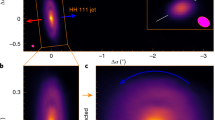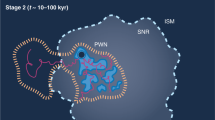Abstract
THERE have been several attempts to estimate the distances of the pulsars using theoretically based models for the free electron distribution in the interstellar medium. A different approach is to make a crude first order approximation that the pulsars are immersed in a uniform dispersing medium, calculate the distances and directions of all pulsars on this assumption and compare the results with the properties of other galactic components, particularly supernova remnants, which would appear to have a common origin. Discrepancies revealed in this comparison may then be used to refine the assumed model of the interstellar medium and improve the distance scale.
This is a preview of subscription content, access via your institution
Access options
Subscribe to this journal
Receive 51 print issues and online access
$199.00 per year
only $3.90 per issue
Buy this article
- Purchase on Springer Link
- Instant access to full article PDF
Prices may be subject to local taxes which are calculated during checkout
Similar content being viewed by others
References
Gould, R. J., Austral. J. Phys., 22, 189 (1969).
Mills, B. Y., Proc. Astron. Soc. Austral., 1, 176 (1969).
Radhakrishnan, V., and Murray, J. D., Proc. Astron. Soc. Austral., 1, 215 (1969).
Author information
Authors and Affiliations
Rights and permissions
About this article
Cite this article
MILLS, B. Pulsar Distances, Spiral Structure and the Interstellar Medium. Nature 224, 504–505 (1969). https://doi.org/10.1038/224504a0
Received:
Issue Date:
DOI: https://doi.org/10.1038/224504a0
This article is cited by
-
Pulsar dispersion measures and the mean and mean-squared interstellar electron density
Astrophysics and Space Science (1971)
-
On the empirical foundations of special relativity
Il Nuovo Cimento B Series 11 (1971)
-
On the Connexion between Pulsars and Supernovae
Nature (1970)
-
Long Baseline Interferometer Measurements of CP 0329
Nature (1970)
Comments
By submitting a comment you agree to abide by our Terms and Community Guidelines. If you find something abusive or that does not comply with our terms or guidelines please flag it as inappropriate.



